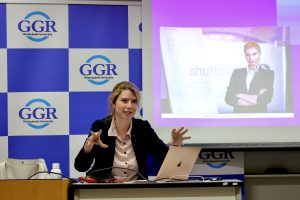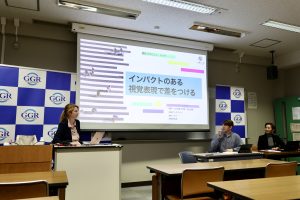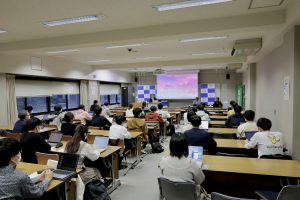On October 6, 2022, the Institute for Global Governance Research (GGR) hosted the workshop titled “How to Make a Difference with Impactful Visuals: From Graphs to Presentations.” The lecturer was Ms. Sascha Hannig Núñez, a Chilean master’s student at Hitotsubashi University’s School of International Public Policy (IPP) and an associate researcher at Instituto Desafíos de la Democracia (Chile). The workshop was held in English with simultaneous interpretation to Japanese by Mr. Michał Skubisz, another master’s student at IPP.
Ms. Hannig started the workshop with an example of a terrible slide to illustrate three mistakes commonly observed in presentations. For example, the slide contained too many colors, used comic sans for the font, and used low-quality images. Ms. Hannig then compared the poorer slide with a proper one, which included softer images that did not attract too much attention.
In the first part of the presentation, Ms. Hannig explained why visuals are fundamental. For example, numerous eye-tracking experiments show how images of faces, rather than texts, attract the audience’s attention. Likewise, the audience tends to look away from dense text to places with less text. Besides, images can help the audience understand complex concepts, and graphs and videos also help to visualize data professionally and aesthetically. Lastly, pictures help the transmission of non-verbal keys that are difficult to communicate with text only.
In the second part, Ms. Hannig mentioned the myths and facts about visuals. For example, images are practical, but the audience cannot understand them without context. Also, the presenter does not need to write down all the essential information on the slides. Regarding color, an equilibrium of colors is critical since neither overly colorful nor black and white slides are optimal for a professional presentation. Finally, the presenter needs to cite the images properly.
After the presentation, Ms. Hannig encouraged the workshop audience to participate in three ten-minute exercises on their personal electronic devices. First, the participants created flyers on their smartphones by only using PowerPoint features. Later, the participants generated a map and a graph online. Finally, the participants designed a three-slide presentation with a cover page announcing the topic and the illustration generated during the second challenge. These exercises were fun and engaging as the participants could apply the lessons learned during the workshop and produce a visually appealing presentation.
【Event Report prepared by】
Shuichi Tanaka (Ph.D. student, Graduate School of Law, Hitotsubashi University)




